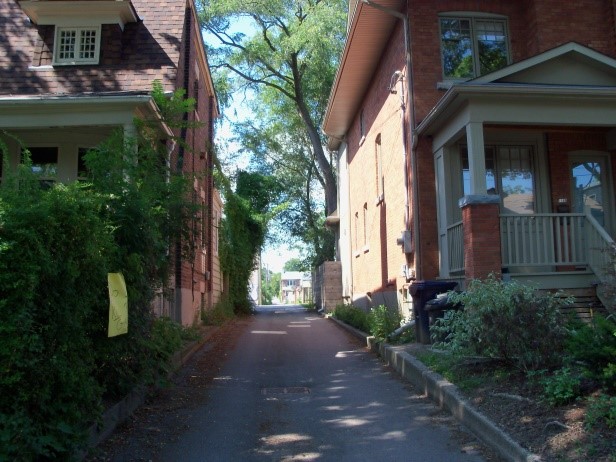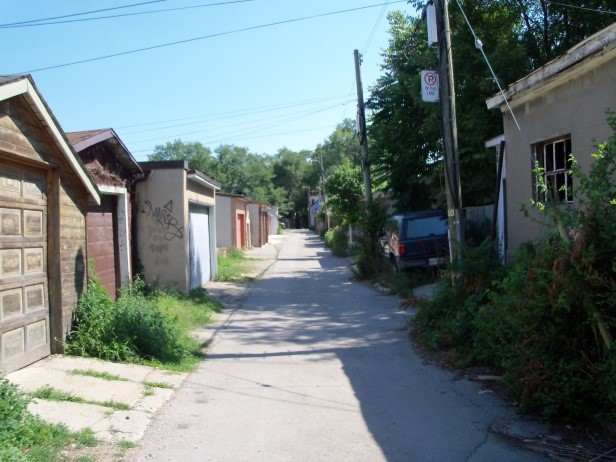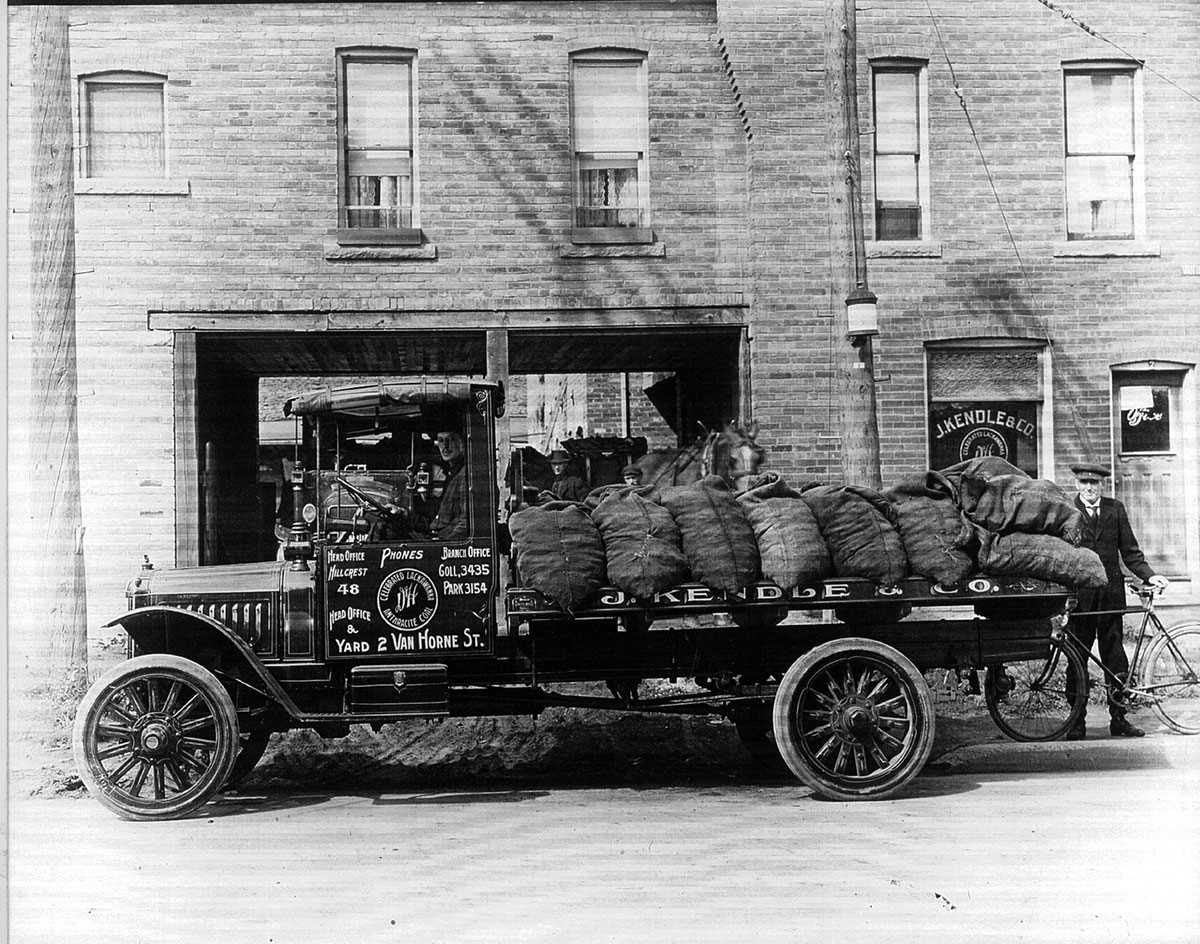
Eunice O'Mahony and Pat Kendle
Described Location: Runs south from Follis and north from Barton Aves, and crosses “Shady Lane”. The lane is between Manning Ave. and Clinton St.
 |
 |
| Looking North from Barton | Looking South from Follis |
Eunice O'Mahony writes: I'd like to nominate the great grandfather of one of my neighbours, Robin Nosko who lives at 805 Manning Avenue - a house built by her great grandfather, James Kendle Sr. This man built several homes in the area including the one I live in-791 Manning. You can see more about this man and his contribution to the history of Seaton Village here: https://www.taddlecreekmag.com/dupont-at-zenith
From "Dupont at Zenith" by Alfred Holden in Taddle Creek, Christmas 1998: James Kendle, early in the eighteen-eighties, took the emmigration gamble and left Newfoundland for Toronto. He put his carpentry skills to work building houses on Palmerston and Manning avenues, where on the latter street he and his young wife, Sybil, a former opera singer from Pennsylvania, settled down at No. 734. In the off-season, James Kendle hauled coal, which proved lucrative, if also competitive. His grandson, James Kendle, Jr., today estimates there were once three hundred to four hundred coal dealers in Toronto, a good chunk of them on the corridor that is now Dupont Street, which is where the railways brought coal and where the Kendle business grew.
A confident and successful James Kendle, Sr., (with bicycle) and his new coal carrier. The Kendle Coal Company would have two yards, one west of Ossington Avenue and the other west of Christie Street next to where the Ford plant became Planter's Nut and Chocolate Company, which it remained for decades. As the years went by, Kendle's edge in this saturated market was the niche he carved out by selling home and business heating customers a special, high-grade Pennsylvania coal. Anthracite, which was very hard and bluish in colour, burned hot and clean. Such was its reputation that in the U.S. the Lackawanna Railroad, which fueled its locomotives with the coal, worked up a memorable billboard campaign around one Pheobe Snow-not the singer, but a young woman who rode trains always dressed in white. She extolled the virtues of the Lackawanna, where clothes wouldn't get dirty from soot. "Says Phoebe Snow: 'The miners know that to hard coal my fame I owe, for my delight in wearing white is due alone to anthracite.' There exist early photographs of a horse-drawn Kendle Coal Company wagon pausing on an Annex-area street of freshly-built homes.
A young man sits stoically at the front, holding the reins in his left hand. The cargo box is loaded with canvas bags full of coal. By the nineteen-twenties, a photo of James Kendle, Sr., now a mature and successful businessman, shows him looking cocky and confident. Holding a bicycle by his side and wearing a cap and tie, he stands on what is now Dupont Street behind a spanking new flatbed truck parked at the curb (a horse and wagon are almost hidden). "J. KENDLE AND COMPANY," says the decal on the truck bed, which is presumably loaded with premium product because there is a seal on the cab door, and the office window behind: "CELEBRATED LACKAWANNA ANTHRACITE COAL." Growing up around a coal yard had its perks. An unlikely one was the Santa Claus Parade, whose route, Kendle, Jr. recalls, at one time followed Van Horne and Dupont streets into midtown before turning south toward Eaton's. "They would back a coal truck up to the lot line and we'd sit on the back of it and watch." As a youth helping haul coal, he'd learn the disadvantages: Santa's November march wreaked havoc with Saturday coal deliveries. Originally shoveled and bagged by hand, coal here was later handled with chutes and conveyors.
Today, Jim Kendle can still rhyme off the names of specialized cuts of anthracite required by the coal era's self-stoking furnaces. "Egg coal, stove coal, nut coal, pea coal, rice coal," Kendle says, "buckwheat coal." One winter day Kendle scored points with a police officer on Davenport Road at the foot of the Bathurst Street hill when he took "a box of ashes from buckwheat coal and spread them over the street. The cars went right up." The cinders are rough, "like bits of popcorn." In wintertime, Kendle delivery trucks carried buckets of buckwheat cinders to help motorists. Says Jim: "It was good P.R." Alas, coal had been in decline since the Second World War. The TransCanada pipeline sealed its fate and with the advent of gas and disappearance of soot Toronto took another leap toward modernity. "End of company, end of an era," Gamester wrote one day in the nineteen-eighties. "Next Monday, Jim Kendle closes the gates forever at the J. Kendle Company on Dupont Street, coal merchants for 105 years." See Also: George Gamester, "Charlie and Jim Shovel Their Last Ton of Coal," Toronto Star, March 25, 1986, p. A2
Obituary for James Kendle Jr.
"Peacefully on September 23, 2014 at North York General Hospital after a lengthy stay at Bayview Extendicare. Beloved husband of 63 years to Doreen "Irish". Loving father of Patricia (the late Ken McKenzie) and the late John. Predeceased by his twin brother Frank (Betty) and lovingly remembered by his many nieces, nephews and their families. He was an avid fisherman, baseball coach, a fan of all sports and a lover of the great outdoors. He was the third generation of a successful family business "Kendle Coal". A kind and generous man, he volunteered for community and youth activities over countless years. His sense of humour and integrity will be sadly missed.
